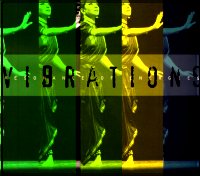 |
 |
VIBRATIONS OF SPANDA by Lada Guruden Singh, New Delhi May 2002 |
 |
| Unlike
young, dynamic and immensely talented Hrithik Roshan, who is a naïve
genius turning insecure since he belongs to film industry where destiny
dates a new star every Friday, Leela Samson is secure in an increasingly
creatively competitive environment and is giving hits and super hits in
a linear fashion that bewilder Delhities who have lately become privy to
vibrant and fresh choreographic works. Vibrations, definitely vibrant and
stunning, is but churned from the old sea. The music is familiar to the
ears. Even the stage where Spanda was premiered long time back was same.
But here the comparisons stop. What makes Vibrations, nee Spanda superlative
is the creative curiosity of Leela Samson. Vibrations was different not
because of the geometric patterns and angular movements or for its hummable
music, but because of the very feeling it generated - this feeling to dance
with the dancers on stage. Like any classic film, this choreography, which
you may address by any name, will always touch the inner chord of the audience.
That’s what Spanda was, that’s what Vibrations is!
Presented by Natya Ballet Centre, New Delhi at the Kamani Auditorium on May 2nd 2002, Vibrations generated a lot of interest in the art circle where most of the “artistes” were busy decoding what the card meant when it said, Vibrations - Performed by Spanda. Those who didn’t know the connection, thought it was a South Indian - American student of Leela Samson! The concept, not new, was awe inspiring, the channels of energies, not maiden, came out of new bodies. What also goes to the credit of Leela Samson is the way she came up with new dancers to dance the archetypal Spanda. Not new in terms of appearance and experience but with respect to Spanda, these dancers achieved near ideal symmetry in a time span of just six days of practice! If the packed hall at Kamani was any indication, Vibrations was a hit right from the word Go. The evening began with “SPANDA MAATRIKA”. This item was pointed towards the process of reducing the movement to its very basic and reaching the origin of the movement. The essence being the origin and the driving force behind it pushing it towards completion. Each movement for each dancer holds a different meaning. Each dancer responds to it differently. What joins different movements of different dancers is the dance space. When the dancer reaches the point of beginning or the OM as some may say, the external environment loses its effect and hold on the being and his / her body. The movement stands liberated from the dance and the dancer is in turn liberated from the movement. That’s what one could feel as one watched the toned dancers capturing the stage. Put to test in Panch Jatis, the idea was netted individually by every performer and in the end, these bodies took to their particular movements to achieve peculiar co- ordination which carried the typical Samson stamp. A feature of this item, which incited a ‘Wow!’ was the creation of audience on stage. More on it later. Talking of dance space, can one forget the obsession of all the human beings with space, universe …AAKASH? Aptly titled AAKASH, the second piece celebrated the space outside and the space within. The current of cosmic energy, which reverberates through the human form stood exposed in here. The theme, richly borrowed from Rig Veda, had a tumultuous start with a haunting music (composed by Madhup Mudgal) and placid bodies throbbing with life as the rhythm and vibrations of music journeyed through them. Their movements resembled that of sea waves with one end of the stage witnessing the movement upwards and the other end, portraying the movement downwards. In a sense, this item inverted what the previous item posited. Here the stress was on fullness and also on the absence of movement. Movement was not important here as it was in SPANDA MATRIKA. Whereas the former was journey inward, this one was journey outward. Even as the Space is called AAKASH, in actuality it’s also about the five elements and without space, can there be these elements and hence human beings? Journey being the only constant thing in our lives, the last piece CHARISHNU, represented the desire of soul and its need to express itself. This piece was an ideal summation of the last two pieces. It appears that the dancers enjoyed this piece more than the last two! This piece had the most appealing dance positions and the burning need to ‘Let Go’ oneself was all too profound. As half of the ten dancers were from Kalakshetra, one enjoyed this number all the more. The compactness of the number and the sharp entry - exit was another magnificent part of CHARSHNU. The racy music and the excited dancers churned an atmosphere of pure enjoyment. Talking of
particular dancers, Chennai based C A Joy struck a right balance between
the sheer physicality of the movement and an imperative need to communicate
with the audience. Malakshmi Kameshwaran was a delight to watch with her
subtle smile and graceful body movements. Kapil Sharma was at his best
as ever! Aditi Rao and Aranyani Bhargav, perfect in Nritta, could smile
more which would have embellished their dance, which was even otherwise
accurate and alert.
Probably, in future this would be stressed upon intensively and who knows, there may be a production on these raw energies. For the time being though, it is Spanda that vibrates around and shall continue to do so till there is a better, sharper and truer production in place by the woman herself- Leela Samson. And it’s an arduous task …something like Mission Impossible? What say you…
|
 |
Delhi
based Lada Guruden Singh is a young Bharatanatyam dancer. A budding poet,
he has to his credit a collection of poems, entitled Split Ends. Lada envisages
a conscious role play for himself in the realm of Dance and Art related
issues in years to come.
e-mail: ladasinghg@yahoo.com |